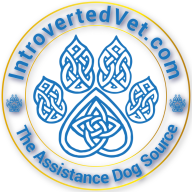The Road to Having a Service Dog, The Framework (US)
So, you have made it this far! Ready for the "meat and potatoes"? Part one we focused on the basics of finding out and agreeing that a service dog would not only be advantageous for the prospective handler but should also be a good fit as a new family member.
As mentioned before your own research is going to be a major player, as it will be throughout your service dog team career.
Budget/Costs
This is always a big one. If you were to go out and buy a trained service dog, they start at about $10,000 (US) and up.
This is a very handler-centric topic. Everyone is going to be different. In the service dog world, we have a couple of breeds we refer to as the "Fab-4", these are Standard Poodle, Labrador Retriever, Golden Retriever, and the Collie. These breeds are the most seen breeds working as service dogs. Their breeds are typically well-suited for most service dog work and their temperament is typically perfect.
This does not mean that those are the only breeds that can do service work. Any dog may be able to become a service dog no matter what the breed. With that being said, only about 30% of all dogs have what it takes to become a service dog.
As a prospective handler, a lot of time should invested in researching the breeds they are interested in. There are many good resources out there to base out a list of good breeds. Doctor Morris over at Psychiatric Service Dog Partners posted a great article on the subject, "Choosing the Right Dog".
Remember this is a lifelong obligation so it is important to find the best fit for you and your family, so being honest with yourself when doing your research is so very important. For example, I have a Border Collie, their energy level is off the charts! Two hours of hard playtime is the minimum for us but we also have to keep him mentally engaged on top of his work schedule and long weekend outings. These can be things that other handlers may not be able to keep up with. What about if the prospective handler is 5'0" and weighs 100 pounds, would a large breed, 100+ pound dog, be ideal?
I found that a pro/con list of breeds helped me out a lot, followed by my getting to know the breeds which narrowed my list helped profusely.
Where to get the Prospective Service Dog?
While there is no real wrong answer to this it is again doing to be a very handler-centric topic. The one thing I would stress is that if the prospect handler is not going to use a group or organization for their prospective service dog get help when picking out a prospective service dog! I would suggest finding a dog trainer who has experience with service dogs, paying them to look over some of the dogs you have found or an interesting litter. This in no way guarantees a successful service dog but will majorly increase the odds. I always suggest an outside trainer for several reasons.
These are normally seen when the prospective handler goes through a program or service dog organization for their dog.
How do you want to train the dog? There are many ways, some may be a good fit for the prospective handler while others might be out of their grasp for many reasons.
Owner Training:
This option of dog training has been very popular over the last few years, it has also become very problematic at the same time. There is nothing to stop an individual from training their dog for service work themselves. In many cases, it can increase the bond between a handler and a dog.
With the advent of so many online tools now the internet has become a great source of information that can be used to assist in training. The main cost for going this route is time and the wherewithal to see the training to its "end" (training never really ends). Owner training normally takes about 2 years which not only is a huge time expenditure, but it can be hard to find the gumption to finish it up. It is a very long road!
Why can it be problematic? The training is not problematic, it is some people who cause the problems.
Some people have decided that their pets should be able to go wherever the owner goes. Owner training stipulations have made it very easy for non-service dog teams to simply label their pet as a service dog. Remember there is no government-provided certification for a service dog team. When this is done, and the dog is not highly trained it tends to cause scenes in public access areas which in turn makes the entire service dog community look bad and tends to cause us a lot of access problems.
Another reason for owner training being problematic is that there are no real standards based on the law for how a service dog team should conform to themselves. While there are several standards out there I like the IAADP standards.
Dog Trainer Based:
Many trainers specialize in training service dog tasks, from basic obedience through advanced tasks. There are many options available for training this way. Board and train is where you pay for the trainer to house the dog through their training with the trainer. These tend to be the most expensive but also tend to have the best results. Trainer visits, where the prospective handler either takes the dog for one one-on-one or group sessions on a set schedule. This gives the handler instructions on what to work on till the next session. These are normally cheaper, but there is a good amount of work to be done by the handler.
Hybrid Training:
This is how I handled training. Most of the training I was able to do myself, but there were times when I would hit a spot where I was simply lost. When I would hit that wall, I would reach out to a trainer and get the help we needed.
Tasks:
Almost forgot this one. The service dog task is the action the dog does to notify its handler of a situation. Deciding on what tasks are needed is based 100% on what the handlers' needs are. I think the easiest way to decide on specific tasks is through conversations with family and medical professionals. The reason is that the symptoms tend to be different for everyone with the same diagnosis. The example I normally give for this is PTSD. While I suffer from PTSD my symptoms are not going to be the same as the next person, meaning while I use my dog to clear rooms and check corners as we are walking does not mean everyone is going to need that also. This is one reason service dogs cost so much, every task is custom fit to the handler.
As mentioned before your own research is going to be a major player, as it will be throughout your service dog team career.
Budget/Costs
This is always a big one. If you were to go out and buy a trained service dog, they start at about $10,000 (US) and up.
- Most trained service dogs run from 20-40k.
- Owner Trained: About 10k when my time, called in trainer help and all considered.
- Vet bills: (cost dependent) I normally spend 200-500/year.
- General Upkeep including grooming: For me around 150/month.
- Insurance: (emergency care) 200/year
- Insurance Riders for Home Insurance Policies: Depends on the company.
This is a very handler-centric topic. Everyone is going to be different. In the service dog world, we have a couple of breeds we refer to as the "Fab-4", these are Standard Poodle, Labrador Retriever, Golden Retriever, and the Collie. These breeds are the most seen breeds working as service dogs. Their breeds are typically well-suited for most service dog work and their temperament is typically perfect.
This does not mean that those are the only breeds that can do service work. Any dog may be able to become a service dog no matter what the breed. With that being said, only about 30% of all dogs have what it takes to become a service dog.
As a prospective handler, a lot of time should invested in researching the breeds they are interested in. There are many good resources out there to base out a list of good breeds. Doctor Morris over at Psychiatric Service Dog Partners posted a great article on the subject, "Choosing the Right Dog".
Remember this is a lifelong obligation so it is important to find the best fit for you and your family, so being honest with yourself when doing your research is so very important. For example, I have a Border Collie, their energy level is off the charts! Two hours of hard playtime is the minimum for us but we also have to keep him mentally engaged on top of his work schedule and long weekend outings. These can be things that other handlers may not be able to keep up with. What about if the prospective handler is 5'0" and weighs 100 pounds, would a large breed, 100+ pound dog, be ideal?
I found that a pro/con list of breeds helped me out a lot, followed by my getting to know the breeds which narrowed my list helped profusely.
Where to get the Prospective Service Dog?
While there is no real wrong answer to this it is again doing to be a very handler-centric topic. The one thing I would stress is that if the prospect handler is not going to use a group or organization for their prospective service dog get help when picking out a prospective service dog! I would suggest finding a dog trainer who has experience with service dogs, paying them to look over some of the dogs you have found or an interesting litter. This in no way guarantees a successful service dog but will majorly increase the odds. I always suggest an outside trainer for several reasons.
- A breeder or kennel wants to sell, they are likely to say whatever it takes to do so.
- A pound typically lacks the experience to make good judgments when talking about service dog work, and they want to get the dogs.
- Pros:
- Best price point normally.
- Helping to find animals a home.
- Cons:
- Worst washout rate for potential service dogs.
- Age. Normally a service dog works for about 8-10 years. Getting an older dog could reduce this time.
- Unknown breed traits.
- Pros:
- Breed Standards.
- Health guarantees.
- Can view the parents and their overall health and traits.
- Cons:
- Cost.
- Contractual terms.
These are normally seen when the prospective handler goes through a program or service dog organization for their dog.
- Pros:
- They find the dog.
- They train the dog.
- They train the handler.
- Refresher training.
- Cons:
- Most expensive option normally.
- You get the dog they put with you.
- Contractual obligations. Read the contract carefully!
- Normally a very long wait for approval as well as delivery.
How do you want to train the dog? There are many ways, some may be a good fit for the prospective handler while others might be out of their grasp for many reasons.
Owner Training:
This option of dog training has been very popular over the last few years, it has also become very problematic at the same time. There is nothing to stop an individual from training their dog for service work themselves. In many cases, it can increase the bond between a handler and a dog.
With the advent of so many online tools now the internet has become a great source of information that can be used to assist in training. The main cost for going this route is time and the wherewithal to see the training to its "end" (training never really ends). Owner training normally takes about 2 years which not only is a huge time expenditure, but it can be hard to find the gumption to finish it up. It is a very long road!
Why can it be problematic? The training is not problematic, it is some people who cause the problems.
Some people have decided that their pets should be able to go wherever the owner goes. Owner training stipulations have made it very easy for non-service dog teams to simply label their pet as a service dog. Remember there is no government-provided certification for a service dog team. When this is done, and the dog is not highly trained it tends to cause scenes in public access areas which in turn makes the entire service dog community look bad and tends to cause us a lot of access problems.
Another reason for owner training being problematic is that there are no real standards based on the law for how a service dog team should conform to themselves. While there are several standards out there I like the IAADP standards.
Dog Trainer Based:
Many trainers specialize in training service dog tasks, from basic obedience through advanced tasks. There are many options available for training this way. Board and train is where you pay for the trainer to house the dog through their training with the trainer. These tend to be the most expensive but also tend to have the best results. Trainer visits, where the prospective handler either takes the dog for one one-on-one or group sessions on a set schedule. This gives the handler instructions on what to work on till the next session. These are normally cheaper, but there is a good amount of work to be done by the handler.
Hybrid Training:
This is how I handled training. Most of the training I was able to do myself, but there were times when I would hit a spot where I was simply lost. When I would hit that wall, I would reach out to a trainer and get the help we needed.
Tasks:
Almost forgot this one. The service dog task is the action the dog does to notify its handler of a situation. Deciding on what tasks are needed is based 100% on what the handlers' needs are. I think the easiest way to decide on specific tasks is through conversations with family and medical professionals. The reason is that the symptoms tend to be different for everyone with the same diagnosis. The example I normally give for this is PTSD. While I suffer from PTSD my symptoms are not going to be the same as the next person, meaning while I use my dog to clear rooms and check corners as we are walking does not mean everyone is going to need that also. This is one reason service dogs cost so much, every task is custom fit to the handler.


















